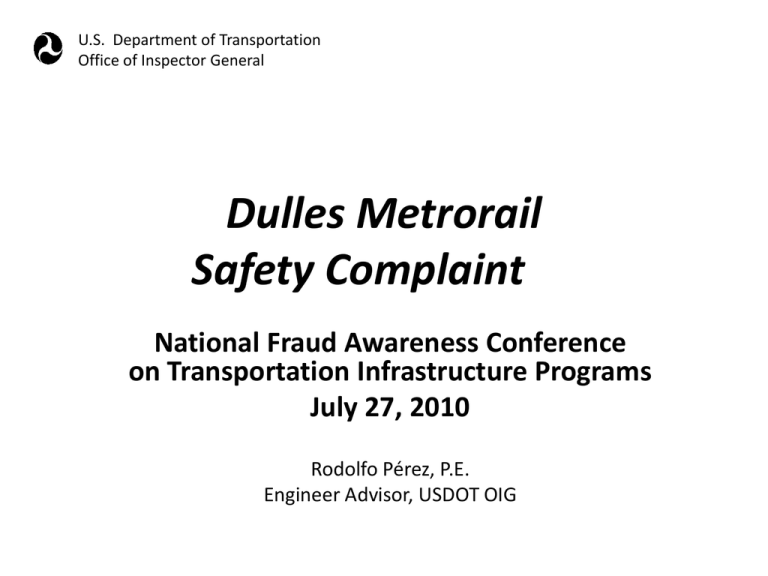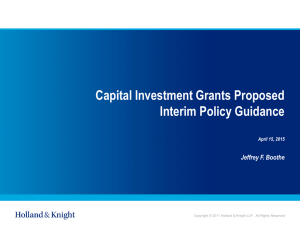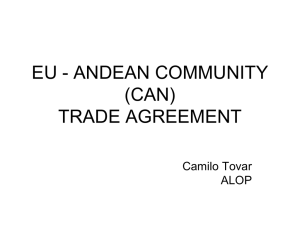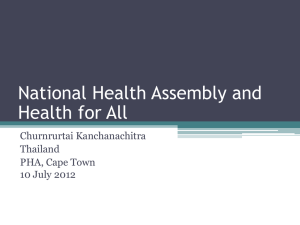2-250 Dulles Metrorail Safety Complain Final
advertisement

U.S. Department of Transportation Office of Inspector General Dulles Metrorail Safety Complaint National Fraud Awareness Conference on Transportation Infrastructure Programs July 27, 2010 Rodolfo Pérez, P.E. Engineer Advisor, USDOT OIG Dulles Metrorail Corridor Project • The Metropolitan Washington Airports Authority (MWAA) is constructing a 23-mile extension of the existing Metrorail system, from Arlington County to Loudon County in northern Virginia in two Phases: • Phase 1 of the Project will include five new stations for the first 11.7 miles of the extension. Construction began in March of 2009 and is now schedule for completion in 2014. • Phase 2 is still in preliminary engineering. As each phase is completed, they will be operated by the Washington Metropolitan Area Transit Authority (WMATA). 2 The “Silver Line” 3 Phase 1 Dulles Metrorail Project 4 Prior OIG Involvement • In July 2007, we issued an audit report that reported on risk indicators that warranted FTA’s close monitoring of the Dulles Project, including the project sponsor’s, Metropolitan Washington Airports Authority (MWAA), lack of experience in transit construction. • We stressed the need for vigilant oversight to prevent the cost increases, schedule delays, and construction quality problems that we had observed on other projects with similar risk indicators. 5 Complaint filed with the OIG Hotline • In September 2008, a complainant brought to the OIG’s attention his allegation that eleven 30-year old foundations to be used in the project were not sufficiently tested for structural safety. • MWAA and its design-build contractor, Dulles Transit Partners (DTP), plan to use these existing foundations to support the elevated track that will span part of I-66 and merge with existing Metrorail track near the West Falls Church Station. 6 After 30 Years, the Existing Foundations are Buried Underground 7 Only One Pier of the Existing Foundations is Visible 8 New Elevated Guideway Alignment 9 EXISTING Buried Foundation The existing foundations must carry a new elevated guideway with railcars and passengers throughout the useful life of the project Elevated Guideway TO BE BUILT 10 Safety complaint to the OIG Hotline • The complainant alleged the Project planned to use eleven 30-year old bridge foundations without sufficient and reliable information to verify their capacity to carry the loads and their long-term durability. • No allegation of fraud but the allegation raised questions about the sufficiency of the testing for the existing foundations. 11 Safety Complaint Explained • During preliminary engineering and early design stages, one visible existing pier was to be used in combination with new piers. Its use was contingent upon load test results (see Elevation Drawing). • As the project advanced into final design, additional buried pile foundations were discovered. DTP decided then to use 10 more of these existing foundations in lieu of building new ones. The complainant alleged that DTP decided to reuse the foundations without: – Verifying that all 11 foundations could carry the required loads and their piles driven as planned. – Verifying the physical condition of the piles at all 11 foundations, to assess whether any damage occurred during 30 years in the ground that could reduce their service life. • Insufficient verification can result in increased life-cycle costs or, in the worst case, cause the collapse of the elevated structure. 12 100 % Preliminary Engineering Drawings / 30% Final Design Drawings Need for Load Capacity Verification Indicated 13 14 Safety Complaint Explained • Complicating the issue, DTP could not locate any original construction records for the existing piles like as-built drawings, pile driving logs, other tests. • Only some design drawings were found, but design drawings do not always represent as-built conditions. • In the absence of construction records, the most reliable method to determine the safety of the piles is to conduct a comprehensive testing plan including pile load tests, inspections and measurements of the piles physical conditions (e.g. steel lost to corrosion) to assess their durability. 15 The First 8 Months • We evaluated the merit of the allegations and then referred the hotline complaint to FTA for action in November 2008. • In June 2009, FTA responded and asked the OIG to “close the safety complaint” based on assurances from MWAA and DTP that the piles “were built according to as-built plans.” 16 FTA Responses to the Hotline • The initial FTA response did not resolve all our concerns (no evidence of a testing plan for all foundations) and the OIG requested additional follow-up in July 2009. • FTA provided a more comprehensive response in September 2009, after having tasked their oversight consultant (PMOC) to review the new information provided by the grantee. However, some of the new information provided contradicted FTA’s initial response. 17 Discrepancies with FTA Responses • We found that there are no as-built drawings of the existing foundations, contradicting FTA’s initial statements. • We found that load tests were done and corrosion measurements taken at two foundations, contradicting initial FTA statements of just one location tested and limited visual inspection. • The corrosion measurements taken called for additional tests to assess the remaining service life of the piles, and for corrosion protection measures. • FTA did not mention in its initial response that WMATA expected 100 years of service life for existing the piles. • After reviewing the new information, the PMOC recommended additional testing of the existing foundations, contradicting FTA’s initial request for closure. 18 OIG Management Advisory • Additional action was warranted to the resolve the contradictions and issues that emerged from the initial response. • As a result, the OIG issued a Management Advisory to the FTA Administrator on October 22, 2009. “A potentially serious safety issue regarding the adequacy of foundations at a segment of the Dulles Corridor Metrorail Project (Dulles Project) remains unresolved nearly a year after we first brought it to the Federal Transit Administration’s (FTA) attention.” 19 FTA Takes Action: A Flurry of Letters follows • On October 2, 2009 FTA issued a letter to MWAA requesting a resolution to their PMOC’s recommendation for additional testing. • After a flurry of letters between MWAA and FTA, FTA was unsatisfied with the MWAA response to the safety concerns. • The FTA Administrator issued a strong letter to MWAA on November 3, 2009, requesting that as Federal grantee – MWAA “take ownership of the testing plan” rather than just forwarding DTP’s proposal. • On December 2, 2009, MWAA responded to FTA with a comprehensive testing plan for the existing foundations. FTA accepted the plan on January 8, 2010 and said they will review its execution. 20 Following discussions with the complainant, the press reported the issue 21 OIG Review Continues • On November 19, 2009, the OIG announced an audit to: 1) Evaluate the effectiveness of FTA’s oversight of the Dulles Corridor Metrorail Project. 2) Assess potential safety concerns. 22 OIG Review Continues • We are evaluating the efficacy of the PMOC as FTA’s resource to oversee the execution of the testing plan to verify the piles’ load capacity and durability for the next 100 years. • We are also evaluating the efficacy of the PMOC’s oversight of the Dulles Project as a whole including how it advises FTA on the project schedule, costs, fleet procurement, and other potential safety risks. 23 OIG Review Continues • We are paying close attention to the testing activities and tests results. • We are also reviewing other project issues such as costs, schedule, and fleet procurement. 24 Final Design Drawings / Issued For Construction Permit No Load Tests Indicated 25 In Conclusion • The OIG hotline works! Structural safety tests that otherwise would not have been done are currently underway. • Proactive Federal oversight ensures the safety of infrastructure projects. 26 Thanks for your attention. 27







